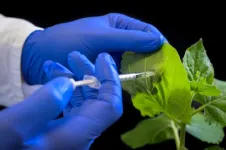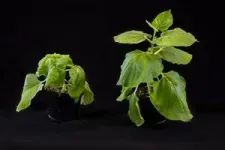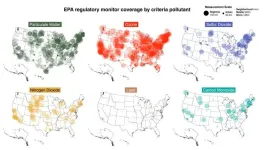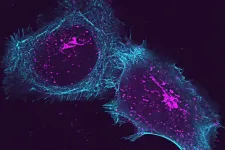(Press-News.org)
New RNA-based active agents reliably protect plants against the Cucumber mosaic virus (CMV), the most common virus in agriculture and horticulture. They were developed by researchers at the Martin Luther University Halle-Wittenberg (MLU). The active ingredients have a broad spectrum effect; a series of RNA molecules support the plant's immune system in combating the virus. In laboratory experiments, 80 to 100 per cent of the treated plants survived an infection with a high viral load, as the team reports in Nucleic Acids Research. Their paper has been selected as a "breakthrough article" by the journal. The researchers are now working on transferring the idea from the laboratory into practice.
Cucumber mosaic virus is a particularly devastating virus for crops. About 90 species of aphids transmit the virus, which affects more than 1,200 plant species. These include numerous agricultural crops such as squash, cucumbers, cereals and medicinal and aromatic plants. Infected plants are easily identified by a characteristic mosaic pattern on their leaves. Once infected, the plants fail to thrive and their fruits cannot be sold. To date, there exist no approved agents against CMV. However, the new work by researchers at MLU could provide a long-term solution. The basic idea is to fight the virus by directing the plant’s natural defences in the right direction.
When a virus infects a plant, it uses the plant's cells as a host. The virus multiplies via its genetic material in the form of ribonucleic acid (RNA) molecules in the plant cells. Once injected, these foreign RNA molecules trigger an initial response from the plant's immune system. Special enzyme scissors recognize and cut the viral RNA molecules. This process produces small interfering RNAs (siRNAs), which spread throughout the plant and trigger a second step of the immune response. The siRNA molecules bind to special protein complexes and guide them to the RNA molecules of the virus. Once there, the proteins begin to break down the harmful RNA molecules of the virus by converting them into harmless, degradable fragments.
"In general, this defence process is not very effective. A viral infection produces many different siRNA molecules, but only a few have a protective effect," says Professor Sven-Erik Behrens from the Institute of Biochemistry and Biotechnology at MLU. His team has developed a method to identify siRNA molecules that are highly efficient in the process. In a further important step, they were now able to combine several of these siRNA molecules into so-called efficient double-stranded RNA molecules (edsRNAs), which are particularly suitable for use in plants. These edsRNAs act as a kind of "package" that is broken down into the siRNAs soon after entering the plant cells. In this way, a large number of highly effective siRNA molecules can exert a protective, antiviral effect on the spot.
The team conducted numerous laboratory experiments on the model plant Nicotania benthamiana and was able to show that edsRNA-based active agents reliably protect against the Cucumber mosaic virus. "The plants in our experiments were infected with a very high viral load: all of our untreated plants died," explains Behrens. In contrast, 80 to 100 per cent of the treated plants survived. There’s another special advantage of edsRNA agents: when the package is broken down, a bunch of efficient siRNA molecules is produced that exclusively attack the virus at different sites. This significantly increases the protective effect. "RNA viruses such as the Cucumber mosaic virus are dangerous because they can evolve rapidly. In addition, the genetic material of this virus is made up of three separate parts, which can get mixed up, further increasing the chance of new mutations. To achieve maximum protection against the virus, our active ingredients target different parts of the genome," says Behrens. The team has also optimized the process of screening for efficient siRNAs and can adapt the procedure to target new viral mutations within two to four weeks. "Time is an important factor: when a new virus variant emerges, we can very quickly modify the active agent accordingly," Behrens explains. The approach may also be applied to other pathogens and pests.
Until now, the substances have been administered manually in the laboratory, either by injection or by rubbing them into the plant leaves. The team is working with pharmacist and drug delivery specialist Professor Karsten Mäder at MLU to make the RNA-based substances more durable and easier to apply to plants. For example, they could be sprayed on. At the same time, the researchers are planning field trials to test the RNA-based substances under real conditions. And they are talking to companies about future industrial production. In addition, potential new crop protection products still have to go through an approval process, so it will be some time before a product to combat Cucumber mosaic virus enters the market. "However, we are convinced that our approach is feasible. The first crop protection product with an RNA-based active ingredient was recently approved in the USA," says Behrens.
The editors of "Nucleic Acids Research" selected the paper by the MLU researchers as a "breakthrough article". Only two to three per cent of the articles published in "Nucleic Acids Research" receive this special designation every year. Around 1,300 articles appeared in the journal in 2024.
The work was funded by the German Research Foundation (DFG), the Federal Ministry of Education and Research (BMBF) and the state of Saxony-Anhalt.
Study: Knoblich M. et al. A new level of RNA-based plant protection - dsRNAs designed from functionally characterized siRNAs highly effective against Cucumber Mosaic Virus. Nucleic Acids Research (2025). doi: 10.1093/nar/gkaf136
END
Protecting crops: Researchers open up new avenue to combat a widespread plant virus
2025-03-19
ELSE PRESS RELEASES FROM THIS DATE:
UCLA discovers first stroke rehabilitation drug to repair brain damage
2025-03-18
A new study by UCLA Health has discovered what researchers say is the first drug to fully reproduce the effects of physical stroke rehabilitation in model mice, following from human studies.
The findings, published in Nature Communications, tested two candidate drugs derived from their studies on the mechanism of the brain effects of rehabilitation, of which one resulted in significant recovery in movement control after stroke in the mouse model.
Stroke is the leading cause of adult disability because most patients do not fully recover from the effects of stroke. There are no drugs in the field of stroke ...
Only around 1 in 10 common non-surgical and non-invasive treatments for back pain effective
2025-03-18
Only around 1 in 10 common non-surgical and non-invasive treatments for lower back pain is effective, suggests a pooled data analysis of the available research, published online in BMJ Evidence Based Medicine.
And the pain relief they offer is only marginally better than that achieved with a placebo, the findings indicate.
Low back pain is common and debilitating, and 80%-90% of it is categorised as non-specific, because there’s no immediately identifiable cause, note the researchers.
Non-surgical and non-invasive ...
Installing safety nets on Golden Gate Bridge linked to 73% decline in suicides
2025-03-18
Early evidence indicates that the installation of safety nets on the Golden Gate Bridge in San Francisco has been successful in reducing the number of suicides at the bridge.
The results, published online in the journal Injury Prevention, show a 73% decline in suicides in the 12 months since the nets were completed relative to the number before net installation began.
The researchers say their findings “highlight the value of installing nets on this bridge and the importance of barriers as a strategy to prevent suicides by jumping.”
The ...
Increasing fruit, fiber, dairy and caffeine linked to lower risk of tinnitus
2025-03-18
Increased consumption of fruit, dietary fibre, dairy products and caffeine may be associated with a reduced risk of tinnitus (ringing in the ears), suggests an analysis of the available evidence, published in the open access journal BMJ Open.
The researchers stress that their findings can’t establish a direct (causal) relationship and should be interpreted with care because of the low quality of the evidence. But they say possible reasons may involve the protective effects of these diets on blood vessels and nerves, as well as their anti-inflammatory ...
Does BMI become useless as we age?
2025-03-18
Body mass index (BMI) is key method for measuring a person’s weight status, and defining if they have normal weight, overweight, or obesity. However, new research to be presented at this year’s European Congress on Obesity (ECO 2025, Malaga, Spain, 11-14 May) shows that people with obesity at similar BMIs display significant differences in body composition in different body compartments according to their age group, such as higher body fat especially in central regions and lower muscle mass ...
Rice statistician earns $1 million CPRIT award to advance AI-powered precision medicine for prostate cancer
2025-03-18
HOUSTON – (March 18, 2025) – Erzsébet Merényi, a statistics research professor at Rice University, and co-investigators at The University of Texas MD Anderson Cancer Center Pratip Bhattacharya, professor of cancer systems imaging, and Dr. Patrick Pilié, assistant professor of genitourinary medical oncology, were awarded $1 million by the Cancer Prevention and Research Institute of Texas (CPRIT) to develop artificial intelligence (AI) tools that can identify lethal forms of prostate cancer earlier and improve treatment selection.
Prostate cancer ...
Whose air quality are we monitoring?
2025-03-18
U.S. Environmental Protection Agency (EPA) air quality monitors are disproportionally located in predominately white neighborhoods, according to University of Utah research. The EPA’s network consistently failed to capture air quality in communities of color across six major pollutants, particularly lead and sulfur dioxide, followed by ozone and carbon monoxide.
EPA regulatory monitors are the key data source driving decisions about pollution reduction, urban planning and public health initiatives. Without equal monitor distribution, the data may misrepresent pollution concentrations, leaving marginalized groups at risk.
“It’s ...
Team Hope rides (again) for cancer research at the Tour de Scottsdale
2025-03-18
For the second year in a row, Mayo Clinic physician Dr. Parminder Singh has organized a team of riders to raise funds for cancer research while tackling the 32- or 62-mile routes of the Tour de Scottsdale.
Singh is a clinical trialist with SWOG Cancer Research Network, a world-renowned organization leading cancer studies across the US and beyond. SWOG trials have led to the approval of 14 cancer drugs, changed more than 100 standards of cancer care, and saved more than 3 million years of human life.
Team Hope’s youngest rider is 11-year-old Misha Rajpal who will take on the full, ...
Researchers find missing link in autoimmune disorder
2025-03-18
Autoimmune diseases, which are estimated to affect more than 15 million people in the U.S., occur when the body responds to immune-system false alarms, and infection-fighting first responders are sent out to attack threats that aren’t there. Scientists have long understood how the false alarms get triggered, but the second step of dispatching the immune response has been a mystery.
Now, scientists at Washington University School of Medicine in St. Louis and the Perelman School of Medicine at the University of Pennsylvania ...
‘Democratizing chemical analysis’: FSU chemists use machine learning and robotics to identify chemical compositions from images
2025-03-18
TALLAHASSEE, Fla. — Florida State University chemists have created a machine learning tool that can identify the chemical composition of dried salt solutions from an image with 99% accuracy.
By using robotics to prepare thousands of samples and artificial intelligence to analyze their data, they created a simple, inexpensive tool that could expand possibilities for performing chemical analysis. The work was published in Digital Discovery.
“We are living in the age of artificial intelligence and big data,” ...




